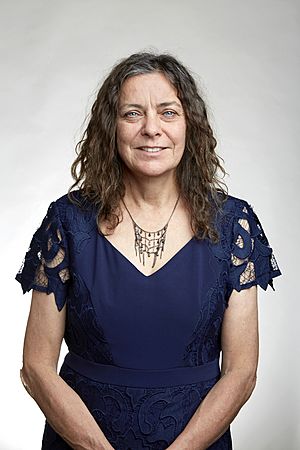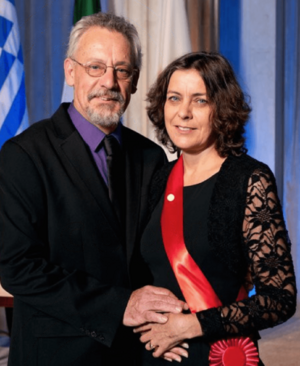Jillian Banfield facts for kids
Quick facts for kids
Jill Banfield
FRS FAA
|
|
|---|---|

Jillian Banfield at the Royal Society admissions day in July 2018
|
|
| Born |
Jillian Fiona Banfield
18 August 1959 |
| Alma mater | Australian National University (BSc) Johns Hopkins University (PhD) |
| Awards | Leeuwenhoek Medal (2023) Fellow of the Royal Society (2018) V. M. Goldschmidt Award (2017) American Society for Microbiology Fellow (2015) Australian Academy of Science (2015) Dana Medal (2010) |
| Scientific career | |
| Fields |
|
| Institutions | University of Melbourne University of Wisconsin–Madison University of Tokyo University of California, Berkeley |
| Thesis | HRTEM studies of subsolidus alteration, weathering, and subsequent diagenetic and low-grade metamorphic reactions (1990) |
| Doctoral advisor | David R. Veblen |
Jillian Fiona Banfield is a famous scientist from Armidale, Australia. She is a professor at the University of California, Berkeley. She also works at the Innovative Genomics Institute and the Lawrence Berkeley National Laboratory. She holds a position at the University of Melbourne in Australia too.
Dr. Banfield is known for her amazing work on tiny living things called microbes. She studies how these microbes live and work together. She also researches very small materials called nanomaterials.
Contents
Early Life and Education
Jillian Banfield studied at the Australian National University. She earned her bachelor's and master's degrees there between 1978 and 1985. Her early studies focused on how granite rocks break down over time.
She became interested in geomicrobiology, which is the study of how microbes affect Earth's processes. This interest grew thanks to Dr. Tony Eggleton. He showed her how minerals and soil change at the Earth's surface.
Later, Dr. Banfield earned her PhD from Johns Hopkins University. Her research involved using a special microscope to study how rocks change.
Career and Research
Dr. Banfield is an earth scientist. She explores how different groups of microbes live and work in nature. She also studies the microbes that live inside humans.
She was a special student at Johns Hopkins University in 1988. She also received a special award called the MacArthur Fellow in 1999. She taught at the University of Wisconsin–Madison from 1990 to 2001. She also taught at the University of Tokyo for a few years.
Since 2001, Dr. Banfield has been a professor and researcher at the University of California Berkeley. There, she leads a program that studies geomicrobiology. She also works at the Lawrence Berkeley National Laboratory. Her research covers many exciting topics. These include studying microbial DNA, developing tools for gene editing, and even looking for life on other planets. She also researches how microbes can help capture carbon to fight climate change.
Discovering CRISPR's Potential
In 2006, Dr. Banfield played a key role in a major scientific breakthrough. She encouraged scientist Jennifer Doudna to study CRISPR. CRISPR is a special part of bacterial DNA. Dr. Banfield noticed that these sequences were common and changed quickly in bacteria.
Jennifer Doudna later won a Nobel Prize for her amazing work on CRISPR. This technology allows scientists to edit genes with great precision.
Leeuwenhoek Medal
In 2023, Dr. Banfield made history. She became the first woman to win the Leeuwenhoek Medal. This award is given by the Royal Dutch Society for Microbiology. It's one of the oldest and most respected awards in microbiology. It honors scientists who have made huge contributions to the field.
Key Scientific Contributions
Genome-Resolved Metagenomics
Dr. Banfield helped create a new way to study microbes called genome-resolved metagenomics. This method lets scientists put together the complete DNA (genome) of individual microbes. They can do this even if the microbes are part of a complex community. This technique has greatly improved our understanding of how diverse microbes are. It also shows how they have changed over time.
Expanding the Tree of Life
Through her work with genomics, Dr. Banfield's team has found many new types of bacteria and archaea. These are tiny, single-celled organisms. Her discoveries have led to a big update of the Tree of Life. This is like a map that shows how all living things are related.
Her research added entirely new branches to this map. These new branches are called Candidate phyla radiation. This has changed how we understand microbial evolution. She once said that most of the Tree of Life is still a mystery to us.
Microbe-Mineral Interactions
Dr. Banfield has also done important work on how microbes interact with minerals. She studies how these interactions can create nanomaterials. These are materials that are incredibly small. Her research also shows how microbes influence Earth's geochemical cycles. These cycles involve how elements move through the Earth's crust, oceans, and atmosphere.
Microbiome Community Editing
Dr. Banfield's research now includes new ways to change microbial communities. This has uses for human health and fighting climate change. Working with Jennifer Doudna, Dr. Banfield has developed new ways to edit the microbiome. The microbiome is the collection of all microbes living in a certain place, like inside our bodies.
Their work combines metagenomics with CRISPR genome editing. This allows them to make specific changes to genes in complex microbial groups. In 2023, they started a big project to use microbiome editing to solve global problems. For human health, they are looking at editing the microbiome to prevent childhood asthma. For climate change, they are targeting microbes in farm animals that produce methane. This could help reduce greenhouse gases from agriculture.
Honours and Awards
- 2023 Leeuwenhoek Medal
- 2018 Elected a Fellow of the Royal Society (FRS)
- 2017 V. M. Goldschmidt Award
- 2015 Elected to the Australian Academy of Science
- 2011 Benjamin Franklin Medal in Earth and Environmental Science
- 2010 Dana Medal
- 2006 Elected to the National Academy of Sciences
- 1999 MacArthur Foundation Fellow
- 1997 Mineralogical Society of America Award


